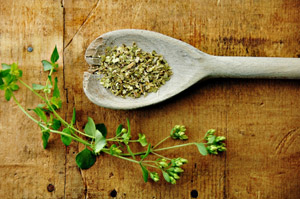In 2014, much of our blog will be focused on the history of different herbs, spices and blends. Each week we will feature a new herb, spice or blend and delve into is origins, uses and more. Make sure to check back each week for the next in our History of Spice series.
This week we will be covering oregano.
The History of Oregano
 Common Name: Oregano
Common Name: Oregano
Latin Name: Origanum vulgare
Other Names: Spanish Thyme, Wild Marjoram, European Oregano
Description
Oregano comes from Origanum, a genus of the mint family (Lamiaceae). Oregano originally came from warm climates in western and southwestern Eurasia and the Mediterranean region. Oregano is a perennial plant that has the characteristics of an herb, green and leaflike, with round shaped leaves. As a perennial, oregano is often grown for 3–4 years but in northern climates where the temperature is colder it is often grown as an annual.
History
Since oregano was originally grown in Greece, it was first used by the Greeks. They believed that this herb was created by the Goddess Aphrodite. She wanted it to be a symbol of joy growing in her garden. The word “oregano” comes from the Greek words oros, for “mountain,” and ganos, for “joy” meaning “ joy of the mountains”.
The Roman’s next adopted oregano because they enjoyed the taste and how easy is was to cultivate. Their love of the herb helped spread its use all throughout Europe and Northern Africa.
In the middle ages oregano was commonly used for medicinal purposes. They would chew the oregano leaves as a cure for many ailments such as rheumatism, toothache, indigestion, and coughing fits.
During this time, Oregano also made the journey to China. It was also used for medicinal purposes in this region. The Chinese people believed it helped with fever, vomiting and upset stomach.
During the Elizabethan era, oregano was used for just about anything. It was used to encourage good luck and good health. It was used in spells for happiness, tranquility, luck, health, protection and letting go of a loved one. It was also worn during sleeping to give one psychic dreams.
Oregano was not widely used in the United States until after the Second World War. Soldiers discovered the herb during the Italian Campaign and brought it back to the US.
Culinary Uses
Oregano is most often used in Italian cuisine. It is a key ingredient in tomato sauces and on pizza, pizza sauces, vegetable dishes and for adding flavor to grilled meat. Oregano is a great substitute for marjoram or thyme if you don’t have these in your spice cabinet.
Medicinal Uses
Ancient Greeks believed that oregano could also be used as a poison antidote. They used it to treat skin irritations and infections, dropsy, convulsions, and as an antidote for narcotic poisons.
Oregano has been used in the treatment of several ailments such as diarrhea, stomach upset and nausea. Oregano also has some anti-bacterial and anti-inflammatory properties so you will see it used in the treatment of arthritis, muscle and joint pain and soreness.




